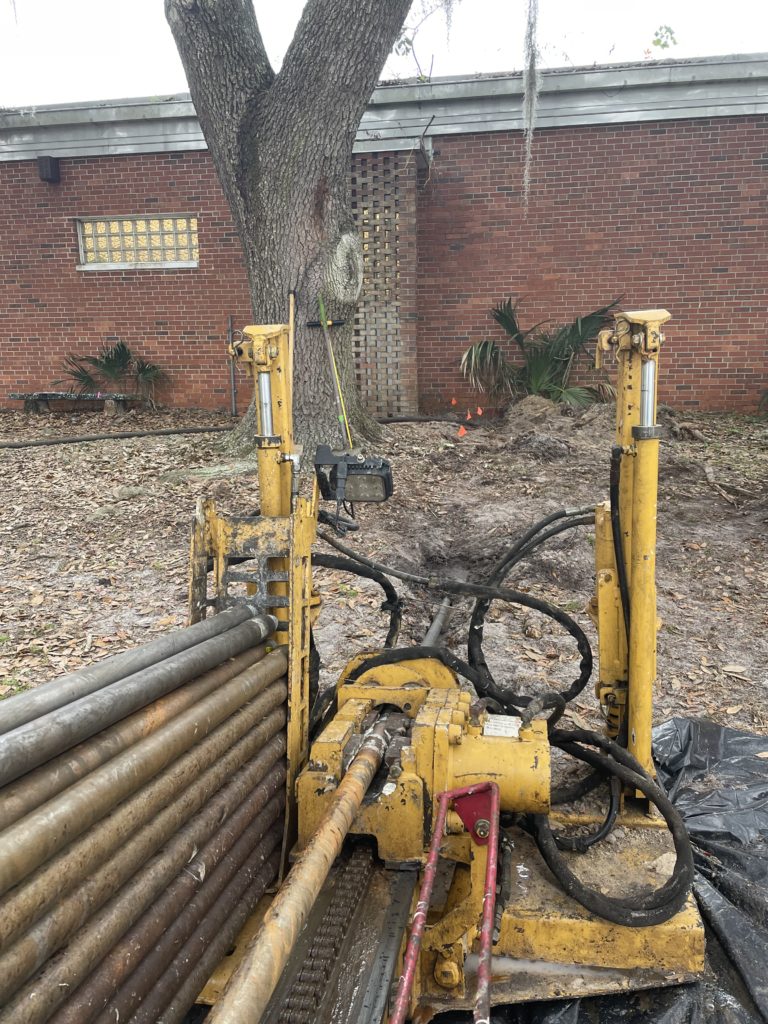Sub Slab Depressurization Wells: Shallow Can Be Tricky
Ellingson-DTD recently completed the installation of three sub slab depressurization wells for the purpose of vapor mitigation at a medical facility in northern Florida.
In the past, the subject property utilized a heating oil tank located adjacent to the building. Petroleum contamination subsequently leaked creating a small plume adjacent to and underneath the building.
Although indoor air sampling indicated that no vapors were entering through the slab, the nature and use of the property as a medical facility warranted extra caution. Directionally drilled sub slab depressurization wells offered something of an insurance policy, with minimal disruption to the occupants.
Shallow Nature of Sub Slab Depressurization Wells Presents Many Challenges
Since sub slab depressurization wells typically never leave the “zone of utilities”, extreme care must be taken. The first step was to locate and mitigate all utilities located in the area. This involved a pre-construction site meeting with the client, property manager and Ellingson. At that time, all the utilities were located and marked using ground penetrating radar and expert knowledge of the blueprints. Eventually it became clear that a drain line would inevitably intersect one of the bore paths. So, Ellingson scheduled to have a Hydro-Vac system present during drilling. Potholing any potential utility in a bore path is a prudent best management practice to avoid utility damage.
Selecting an appropriate screen depth is another challenge when directionally drilling sub slab depressurization wells. Since mass removal is not really the goal, a large blower is not necessary for the vapor extraction system. For this reason, engineers typically prefer as shallow of an installation depth as possible to minimize the necessary blower horsepower. However, very shallow installation depths run the risk of “frack out” or “inadvertent returns” during drilling. In other words drilling fluid might daylight inside of the building.
While many different variables contribute to the probability of a frack out during drilling operations, Ellingson typically recommends a minimum installation depth of 3-5ft. For this project, each well targeted the relatively shallow depth of 36-inches beneath the building’s slab with screen extending the total length of the building (~40ft of screen).
Tree Roots Provide Added Twist to Complicated Underground Picture
Geology consisted of course sands which allowed for easy drilling and adequate borehole stability. However, one of the major project challenges were the very large live oak trees located at the bore entry locations.
Great care was taking not to damage the trees above or below. The very large and sturdy root systems actually impeded the bore path, requiring the drill rig to be repositioned several times. Eventually the drilling crew managed to find a rig position that avoided the roots and still met well design objectives.

Tree roots presented an added subsurface challenge for these directionally drilled sub slab depressurization wells
The crew installed, grouted and developed all of the wells one day ahead of schedule and the vapor mitigation system was up and running within a week of project completion.
Vacuum monitoring points installed in the slab indicate that the depressurization wells are working exactly as designed providing adequate coverage for the entire building footprint.
Tags: horizontal wells, sub slab, SVE, vapor intrusion